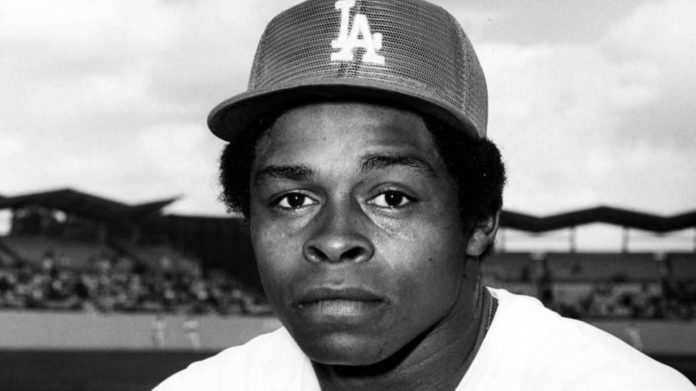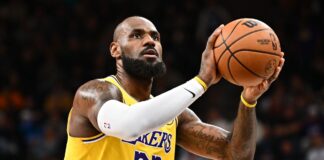
Glenn Burke, one of the most important sports figures to wear a Wolf Pack uniform, slid under the radar, both during his time at Nevada and during his stint in the big leagues.
But Burke’s story, the focus of “Singled Out,” a new book by New York Times bestselling author Andrew Maraniss, gives a fascinating examination of Burke’s life, from the highs of making it to the big leagues by age 23 to the tragic end of cocaine addiction, homelessness and dying of complications from AIDS at 42.
The Oakland, Calif., native was the first openly gay baseball player in Major League Baseball, the inventor of the high five and the first to wear Nikes during a big-league game. A gregarious and amiable man despite a rough childhood (his father was abusive and most likely an alcoholic), Burke overcame great odds thanks to his unconscionable athleticism and magnetic charisma.
“I would describe Glenn as like a glistening mirror ball at the discotheque when the light hits it and all of these different reflections and colors flash all over the room,” former big leaguer Tito Fuentes said.
The book traces Burke being forced into living a double life, a challenge that ultimately pushed him out of the game. He was simultaneously beloved by teammates (for his personality) and degraded by management (for his sexual orientation) throughout his career, at one point being offered a years’ salary to marry a woman.
Burke’s sexual awakening intersected with his brief time at UNR. While Burke made it to the big leagues in baseball, basketball was his first love. One of his dying regrets was pursuing baseball rather than basketball professionally, a result of the Los Angeles Dodgers giving him a $5,000 signing bonus (there’s a funny anecdote in the book about Burke refusing to meet with the Dodgers’ scout because he grew up a Giants fans).
So focused on athletics, Burke didn’t truly realize he was gay until 1974, his third season in the minor leagues. That same year, the NCAA ruled players who were pros in one sport could compete collegiately in another. Burke grew up in the Bay Area playing baseball with Pete Padgett, who was the star of the Nevada basketball team under his father and coach, Jim, who was run out at Cal in part because he recruited too many black players for the liking of some white fans. He even had to check under his car for potential explosives from time to time.
Playing for the Wolf Pack was just a pit stop for Burke, who lasted only a handful of games at Nevada despite averaging 16 points, 5 assists and 4 rebounds per game in his first six contests. He chafed at curfew, class and the structure that came with playing team ball. He was one of the few black students on campus and was grappling with his newfound sexuality, which also was taboo in Nevada. A rift with Jim Padgett — Burke thought he was forcing Pete as the team’s star — eventually led to him quitting the team.
But Burke left an imprint on his Wolf Pack teammates and campus friends, who were devastated by his departure despite his short stay at UNR.
“Glenn is one of those people in your life you’ll never forget no matter how short a time you spent with him,” Wolf Pack teammate Chalmer Dillard said.
With basketball in his rearview mirror, Burke focused on baseball and reached the big leagues in 1976. A year later, he was starting for the Dodgers in the World Series against the rival Yankees. And despite some struggles hitting the ball — he posted a .248 average with the Dodgers — he was an indispensable part of the team, according to All-Star teammates like Reggie Smith, Steve Garvey, Davey Lopes, Don Sutton and Dusty Baker.
“He was the life of the party,” said Baker, one of Burke’s staunches defenders. “He was the most fun-loving dude, and he could dance like James Brown or Michael Jackson. He was so light on his feet. The girls would flock to him and ask him to dance. But at the end of the night, he’d go home by himself every time.”
Everything would unravel after that 1977 season. He was pressured by the image-conscious Dodgers management, namely GM Al Campanis and manager Tommy Lasorda, to marry a woman and was offered $75,000, a full years’ salary to do so. That was, in part, a reaction to Burke having a relationship with Lasorda’s son, Spunky, although the exact details of that relationship remained hazy. Burke was eventually traded to the A’s for journeyman Bill North.
The transaction brought several Dodgers players to tears.
“Glenn? Why? What?” Lopes pleaded with Dodgers management. “You traded our best prospect. Not to mention the life of the team.”
When Baker asked team trainer Bill Buhler why Burke was traded, he answered bluntly: “They don’t want any gays on the team.”
While Burke was beloved and largely supported by his Dodger teammates, the same wasn’t true with the A’s. His fresh start ended up being the end of the road, with teammates (“Don’t bend over in the shower. Here comes Glenn.”), fans (he fought one in a parking lot after being called a f– during the game) and A’s manager Billy Martin (who told his players “That’s Glenn Burke, and he’s a fa—-“) leading him to quit, not once but twice.
In retirement, Burke came out publicly during an interview with Bryant Gumbel on the Today Show in 1982. And while he had many glorious moments after baseball, including captaining a Bay Area softball team to great success and giving the gay community a point of pride and somebody to rally around, his post-baseball life quickly deteriorated.
“He was the gay celebrity in town in the late seventies and early eighties,” said Jack McGowan, a sportswriter and manager at the Pendulum. “He treated us like he was one of us. He didn’t treat us like we were dirt. That was so thrilling for us in the gay community. He was great for our egos.”
But Burke’s celebrity turned into tragedy. He was hit by a car in 1987, breaking both legs, was arrested on drug charges in 1991 as addiction overtook his life and sold his World Series runner-up ring. He contracted HIV and spent his final weeks in his sister’s home withering away, trying to survive long enough to see his biography published (he didn’t make it).
Burke died at 42 best known for creating the high five and being the first baseball player to wear Nikes during a game, both a result of Burke’s magnetic personality (he befriended a concessionaire who worked at a store that would become Nike). Maraniss does an expert job of telling Burke’s life story beyond those headlines, painting a portrait of a man who on the outside was as fun loving a human as you’ll ever meet, but also one who fought with internal demons. It was especially painful to see Burke’s boyfriend use him as a public relations tool, outing him to the San Francisco Chronicle at one point.
“I didn’t know what I’d do for work,” Burke said upon retiring. “But I had been able to put some money away from playing ball. I figured I would amount to little more than a freak. But at least this freak, me, Glenn Burke, was finally going to live his own life. I’d never have to look over my shoulder again.”
The book is interlaced with the stories of Anita Bryant (a beauty queen who ran the anti-gay “Save Our Children” campaign), Harvey Milk (the U.S.’ most pro-LGBT politician in 1970s before his assassination), the disco era and the AIDS epidemic, which helps paint the broader picture of the times Burke was living through as a gay man in a hetero-dominated sport.
Amazingly, more than 40 years since Burke last played in the big leagues, there still hasn’t been an openly gay player in the big leagues while he was an active player, showing the resistance the sport still provides. Burke’s story was both exhilarating and devastating, a once-in-a-lifetime personality being sapped by his sexual orientation.
“He was the most lively personality I ever covered in 45 years in sports,” said journalist Lyle Spencer, who traveled with the Dodgers. “It’s hard to even compare him with anybody.”
Columnist Chris Murray provides insight on Northern Nevada sports. Contact him at crmurray@sbgtv.com or follow him on Twitter @ByChrisMurray.








